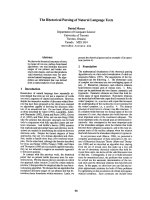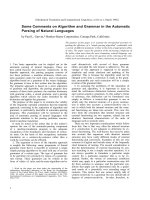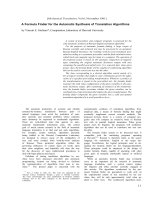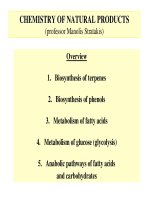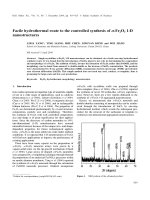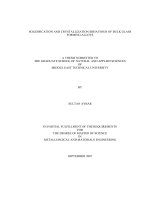Volume 5 the total synthesis of natural products
Bạn đang xem bản rút gọn của tài liệu. Xem và tải ngay bản đầy đủ của tài liệu tại đây (15.34 MB, 556 trang )
Total Synthesis Of Natural Products, Volume 5
Edited by John Apsimon
Copyright © 1983, by John Wiley & Sons, Inc.
THE TOTAL SYNTHESIS
OF NATURAL PRODUCTS
The Total Synthesis
of Natural Products
VOLUME 5
Edited by
John ApSimon
Ottawa -Carleton Institute for Research
and Graduate Studies in Chemistry
and
Department of Chemistry
Carleton University, Ottawa
A WILEY-INTERSCIENCE
PUBLICATION
JOHN WILEY & SONS
New York
Chichester
Brisbane
Toronto
Singapore
A NOTE TO THE READER
This book has been electronically reproduced tiom
digital information stored at John Wiley & Sons,Inc.
We are pleased that the use of this new technology
will enable us to keep works of enduring scholarly
value in print as long as there is a reasonable demand
for them. The content of this book is identical to
previous printings.
Copyright 0 1983 by John Wiley & Sons, Inc.
All rights reserved. Published simultaneously in Canada.
Reproduction or translation of any part of this work
beyond that permitted by Section 107 or 108 of the
1976 United States Copyright Act without the permission
of the copyright owner is unlawful. Requests for
permission or further information should be addressed to
the Permissions Department, John Wiley & Sons, Inc.
Libnwy of Congress Cataloging in Publication Data:
ApSimon, John.
The total synthesis of natural products.
Includes bibliographical references.
1. Chemistry, OrganiGSynthesis. I. Title.
QD262.A68
547l.2
72-4075
ISBN 0-471-09808-6 (v. 5 )
Printed in the United States of America
10987654321
Contributors
to Volume 5
Samuel L. Graham, Department of Chemistry, University of California, Berkeley
Clayton H. Heathcock, Department of Chemistry, University of California,
Berkeley
Michael C. Pirmng, Department of Chemistry, University of California, Berkeley
Frank Plavac, Department of Chemistry, University of California, Berkeley
Charles T. White, Department of Chemistry, University of California, Berkeley
Preface
The art and science of organic synthesis has come of age. This is nowhere
more apparent than in the synthetic efforts reported in the natural
products area and summarized in the first four volumes of this series.
This present volume describes the synthetic activities reported for a
10-year period only in the sesquiterpene field-evidence enough for the
successful efforts of the synthetic organic chemist in recent years.
Professor Clayton Heathcock and his colleagues have produced a masterly, timely and important contribution, the breadth of which necessitates a complete volume in the series.
The sixth volume in this series is in an advanced stage of preparation
and will contain updating chapters on the subject matter included in the
first two volumes together with a description of synthetic efforts in the
macrolide field. A seventh volume, covering diterpene synthesis, is in
preparation.
JOHN APSIMON
Ottawa, Canada
October 1982
vii
Contents
The Total Synthesis of Sesquiterpenes, 1970- 1979
1
CLAYTON
H. HEATHCOCK
SAMUEL
L. GRAHAM
MICHAEL
C. PIRRUNG
FRANKPLAVAC
T. WHITE
CHARLES
Index
543
ix
Total Synthesis Of Natural Products, Volume 5
Edited by John Apsimon
Copyright © 1983, by John Wiley & Sons, Inc.
Total Synthesis of
Sesquiterpenes,
1970-79
CLAYTON H. HEATHCOCK, SAMUEL L. GRAHAM,
MICHAEL C. PIRRUNG, FRANK PLAVAC, AND
CHARLES T. WHITE
Department of Chemistry,
UniversiQ of California,
Berkeley, California
1.
2.
Introduction
Acyclic Sesquiterpenes
A. Farnesol and Farnesene
B. Terrestrol, Caparrapidiol, and Caparrapitriol
C. Juvenile Hormone
D. Sinensals
E. Fokienol, Oxonerolidol, and Oxodehydronerolidol
F. Gyrindal
G . Sesquirosefuran and Longifolin
H. Davanafurans
I
5
6
6
9
11
17
22
24
25
21
2
Contents
I.
3.
4.
Dendrolasin, Neotorreyol, Torreyal, Ipomeamarone, Freelingyne,
and Dihydrofreelingyne
Monocyclic Sesquiterpenes
A. acurcumene, Dehydro-a-curcumenes, Curcuphenol,
Xanthorrihizol, Elvirol, Nuciferal, or-Turmerone, Curcumene
Ether, and Sydowic Acid
B. Sesquichamaenol
C. Bisabolenes, Lanceol, and Alantone
D. a-Bisabolol, adisabololone, Deodarone, Juvabione,
and Epijuvabione
E. Deoxytrisporone, Abscisic Acid, and Latia Luciferin
F. Caparrapi Oxide, 3P-Bromo-8-epicaparrapi Oxide, Ancistrofuran,
Aplysistatin, and a- and @-Snyderols
G. Isocaespitol
H. Lactaral
I. y-Elemene, @-Elemenone,Shyobunone, and Isoshyobunone
J. Saussurea Lactone and Temsin
K. Vernolepin and Vernomenin
L. Pyroangolensolide and Fraxinellone
M. Ivangulin, Eriolanin, and Phytuberin
N. Hedycaryol, Preisocalamendiol, Acoragermacrone, Costunolide,
Dihydrocostunolide, Dihydroisoaristolactone,and Periplanone-B
0. Humulene
Bicarbocyclic Sesquiterpenes; Hydronaphthalenes
A. Eudesmanes
(1) Occidol, Emmotin H, Rishitinol, and Platphyllide
(2) a-Cyperone, P-Cyperone, /I-Eudesmol, and 8-Selinene
(3) Juneol, 10-Epijuneol, and 4-Epiaubergenone
(4) Cuauhtemone
(5) P-Agarofuran, Norketoagarofuran, and Evuncifer Ether
(6) Rishitin and Glutinsone
(7) Occidentalol
(8) Santonin, Yomogin, Tuberiferine, Alantolactone, Isotelekin,
Dihydrocallitrisin, and Frullanolide
B. Cadinanes
(1) Aromatic Cadinanes
(2) d a d i n e n e , yz-Cadinene, a-Amorphene, Zonarene,
and Epizonarene
(3) a-Cadinol and Torreyol
C. Drimanes
(1) Driman-8-01, Driman-8,1l-diol, and Drim-8-en-7-one
(2) Confertifolin, Isodrimenin, Cinnamolide, Drimenin,
Futronolide, Polygodial, and Warburganal
28
35
35
46
47
55
68
75
81
84
84
90
93
107
109
114
122
124
124
124
129
134
136
137
140
143
149
157
157
161
166
169
169
170
5.
Contents
3
(3) Pallescensin A
D. Eremophilanes
(1) Valencene, Nootkatone, 7-Epinootkatone, Isonootkatone, and
Dihydronootkatone
(2) Fukinone and Dehydrofukinone
(3) Isopetasol, Epiisopetasol, and Warburgiadone
(4) Eremophilone
( 5 ) Furanoeremophilanes
(6) Cacolol
E. Miscellaneous Hydronaphthalenes
(1) Valeranone and Valerane
(2) Khusitine and 8-Gorgonene
F. Hydronaphthalenes Containing an Additional Cyclopropane Ring
Other Bicyclic Sesquiterpenes
A. Isolated Rings
(1) Taylorine and Hypacrone
(2) Cuparene, a-Cuparenone, and 8-Cuparenone
(3) Laurene and Aplysin
(4) Trichodiene, Norketotrichodiene, 12,13-Epoxytrichothec-9-ene,
Trichodermin, and Trichodermol
( 5 ) Debromolaurinterol Acetate
B. Bridged Systems
(1 1 Camphorenone, Epicamphorenone, a-Santalene, a-Santalol,
8-Santalene, epi-@-Santalene,@-Santalol,and Sesquifenchene
(2) a-bans-Bergamotene
C. Spirocyclic Systems
(1) Spirovetivanes
(2) Acoranes
(3) Axisonitrile-3
(4) Chamigrenes
D. Fused Ring Compounds: 3,6
(1 Bicycloelemene
(2) Sirenin and Sesquicarene
E. Fused Ring Compounds: 5,s
(1 1 Pentalenolactone
F. Fused Ring Compounds: 5,6
(1) Hypolepins and Pterosin B
(2) Bakkenolide A
(3) Oplopanone
(4) Picrotoxinin
G. Fused rings: 5,7
(1) Guaiazulenes: Bulnesol, a-Bulnesene, Guaiol,
Dehydrokessane, and Kessanol
178
180
180
188
192
195
202
212
215
215
218
221
228
228
228
230
235
238
248
249
249
263
264
264
284
306
306
313
313
314
318
318
323
323
325
327
330
333
333
4
6.
7.
Contents
(2) Guaianolides: Dihydroarbiglovin and Estafiatin
(3) Guaiazulenes with an Additional Cyclopropane Ring:
Cyclocolorenone, 4-Epiglobulo1, 4-Epiaromadendrene,
and Globulol
(4) Pseudoguaianolides: The Ambrosanolide Family;
Deoxydarnsin, Darnsin, Ambrosin, Psilostachyin, Stramonin B,
Neoambrosin, Parthenin, Hymenin, Hysterin, Damsinic Acid,
and Confertin
(5) Pseudoguaianolides: The Helenanolide Family; Helanalin,
Mexicanin, Linifolin, Bigelovin, Carpesiolin, Aromaticin,
and Aromatin
(6) Other Hydroazulenenes: Duacene, Daucol, and Carotol
(7) Other Hydroazulenes: Velleral, Pyrovellerolactone, and
Vellerolactone
H. Fused Ring Compounds: 6,7
(1) Himachalenes
(2) Perforenone
(3) Widdrol
I. Fused Ring Compounds: 4,9
(11 Isocaryophyllene
Tricarbocyclic and Tetracarbocyclic Sesquiterpenes
A. Fused Systems
(1) Illudol, Protoilludanols, and Protoilludenes
(2) Marasmic Acid and Isomarasmic Acid
(3) Hirsutic Acid C, lsohirsutic Acid, Hirsutene, and Coriolin
(4) Isocomene
B. Bridged Systems
(1) Gymnomitrol
(2) Copacamphor, Copaborneol, Copaisoborneol, Copacamphene,
Cyclocopacamphene, Ylangocamphor, Ylangoborneol,
Ylangoisoborneol, Sativene, Cyclosativene, cis-Sativenediol,
Helminthosporal, and Sinularene
(3) Longifolene, Longicyclene, Longicamphor, and Longiborneol
(4) Copaene, Ylangene, and Longipinene
(5) isocyanopupukeanenes
(6) Patchouli Alcohol and Seychellene
(7) Zizaene (tricyclovetivene), Zizanoic Acid, Epizizanoic Acid,
and Khusimone
(8) a-Cedrene, Cedrol, A2-Cedrene and Cedradiene
(9) Quadrone
(10) Isolongifolene
(1 1) Ishwarone and Ishwarane
Sesquiterpene Alkaloids
341
344
347
369
377
381
384
384
388
389
391
391
393
393
394
398
405
41 9
424
424
429
446
452
455
460
473
484
488
492
493
498
Introduction
A. Illudinine
B. Deoxynupharidine, Castoramine, Deoxynupharamine,
and Nupharamine
C. Dendrobine
References
5
498
500
510
520
1. INTRODUCTION
The first total synthesis of a sesquiterpene was Ruzicka's farnesol synthesis, communicated in 1923.' In Volume 2 of this series, we reviewed
the sesquiterpene total syntheses which had been published since that
time, up to the middle of 197OS2That review, covering a 47-year period
and including about 300 papers, required 361 pages. In the intervening
decade since our initial survey of the field there has been a veritable
explosion of activity. In this chapter, we review a further 533 papers
dealing with the total syntheses of over 260 different sesquiterpenes. We
have made an effort to include all papers dealing with sesquiterpene total
synthesis which appeared in the literature through the end of 1979. In
addition, we have added a few papers which were inadvertently omitted
from the first installment of this review, and have included a few which
were either published while the review was under preparation during
1980 or were communicated to us in the form of preprints during that
time. Although some of the 1970-1979 papers are improved routes to
molecules previously prepared by total synthesis, most of them are new.
The general organization of the earlier review' has been followed, with
some modification. In general, we have grouped the syntheses according
to the number of carbon rings:. acyclic, monocyclic, bicyclic, and tri- and
tetracyclic. Compounds containing a cyclopropane ring are generally
included with the class which would contain the molecule with the
cyclopropane ring absent. This arbitrary decision has been made since
many of these syntheses are simple extensions of syntheses of a parent
with addition of the cyclopropane ring being an additional terminal step.
In addition, the review now includes a separate section for sesquiterpene
alkaloids.
6
Acycllc Sesqulterpenes
As before, not all relay total syntheses are included. The general rule
of thumb is that a relay synthesis is included only if the Anal product
differs in carbon skeleton from the starting material. Thus, conversion
of santonin into a germacrane or elemane would be included, but
conversion into another eudesmane would not. The core of the review
is the flow charts, which outline the syntheses. We have described the
syntheses in words, sometimes rather succinctly and sometimes in more
detail. We have attempted to point out novel chemistry or unusual synthetic strategy and have sometimes offered a brief critique of the synthesis.
One of the most interesting aspects of a field such as sesquiterpene
synthesis is comparison of the various strategies which different workers
have employed for a given target. Consequently, we have been more
verbose in discussing such comparative syntheses in several cases, such
as occidentalol, the vetivanes, the acoranes, the pseudoguaianolides, vernolepin, gymnomitrol, and dendrobine. For the purpose of comparing
the efficiency of different syntheses, we generally use the criteria of
number of steps, overall yield, and the number of isomer separations
required in the synthesis.
2. ACYCLIC SESQUITERPENES
A. Farnesol and Funesene
Corey and Yamamoto have reported the e.dgant synthesis of
trans, mns-farnesol which is outlined in Scheme l.3 The synthesis
features a method for stereospecific synthesis of olefins from poxido
phosphonium ylides and aldehyde^.^ Thus, the phosphorane derived
from salt 2 is treated first with aldehyde 3 at low temperature to give the
p-oxido phosphonium salt 4, which is deprotonated and treated with formaldehyde to obtain allylic alcohol 5, uncontaminated by the trans&diastereomer. The allylic hydroxyl is removed by the reduction of the
bisulfate ester and the terminal hydroxyl is deprotected to obtain farnesol (7).
Farnesol and Farnesene
7
2
I
+PPh3
HO
h:
IH- [
I. C~H~JN-SO~
2. LiAlH4
6
Scheme 1.
\5
OTHP
\
0-25'
H3ofLA-An
'
OH
7
Corey-YamamotoSynthesis of Farnesol
Pitzele, Baran, and Steinman, of Searle Laboratories in Chicago, have
studied the alkylation of the dianion of 3-methylcrotonic acid (81, with
geranyl bromide (Scheme
After addition of the geranyl bromide,
8
10
Scheme 2.
Searle Synthesis of Methyl Farnesate
8
Acyclic Sesquiterpenes
methyl iodide is added to obtain the methyl esters. Isomers 10, 11, and
12 are obtained in a ratio of 2.3:2.1:1.0; methyl farnesate (11) of 89%
isomeric purity may be obtained by low pressure chromatography in 26%
yield, based on geraniol.
0. P. Vig and co-workers report a synthesis of p-farnesene (17)
wherein the dianion of acetoacetic ester is alkylated with geranyl bromide
and the resulting p-keto ester transformed into a butadiene unit as
shown in Scheme 3.6 It is not quite clear from their paper just what they
synthesized, since both geraniol and p-farnesene are depicted as having
Z double bonds.
13
14
I . H30+
0
\
IS
\
Ph3P=CH;
/ -
16
IT
Scheme 3.
Vig’s Synthesis of p-Farnesene
Otsuka and his co-workers at Osaka University have reported the most
direct sesquiterpene synthesis yet -direct trimerization of isoprene
(Scheme 41.’ Several catalysts were found which give a preponderance of
the linear trimers 17-19. The best system for production of p-farnesene
Terrestral, Caparrapidiol, and Caparrapitriol
9
19
Scheme 4.
Otsuka's p-Farnesene Synthesis
(17) utilizes [NiCl(r13-C3H5)12-A~(n-CgH,3)3
and t-BuOK. If the reaction is stopped at 30% conversion of the isoprene, p-farnesene comprises
57% of the product. Unfortunately, preparative glpc is required to
separate 17 from its isomers.
B. Terrestrol, Caparrapidiol, and Caparrapitriol
Terrestrol, (35b2,3-dihydrofarnesol (201, is the marking perfume of the
small bumble bee. Caparrapidiol (21) and caparrapitriol (22) are plant
sesquiterpenes which contain centers of chirality.
OH
20
21
22
Ahlquist and Stallberg-Stenhagen of the University of Goteborg in
Sweden have synthesized both enantiomers of terrestrol by way of the
Kolbe electrolysis of homogeranic acid (23) with the enantiomers of
monomethyl 3-methylglutarate (24, Scheme 5).* Ester 25 is obtained in
8Yo yield, based on homogeranic acid.
10
Acyclic Sesquiterpews
I
U
C
O
O
H
+-
HOOC-COOMr
23
24
LiAIH,
I
U\ C
\
O
O
rlrctrolyrir
M
a
26
20
H
Ahlquist-Stiillberg-Stenhagen Synthesis of Terrestrol
Scheme 5.
A synthesis of caparrapidiol by 0. P. Vig is summarized in Scheme 6.9
The question of diastereoisomerism in the formation of 21 is not
addressed by the authors, who simply state that “...The identity of the
synthesized compound was established by comparing its IR and NMR
(spectra) with those reported in literature.”
27
13
30
29
31
Scheme 6.
21
Vig’s Carrapidiol Synthesis
Juvenile Hormones
11
Weyerstahl and Gottschalk, at the Technical University of Berlin, have
synthesized caparrapitriol as shown in Scheme 7.'' As in the Vig synthesis of caparripidiol, the German group makes no mention of a
diastereomeric mixture in the addition of vinyllithium to methyl ketone
35. However, in this case the final trio1 is obtained as a sharp-melting
solid (mp 78-79°C) in 9096 yield! Chromatography on starch provides
one pure enantiomer of caparripitriol.
32
34
22
35
Scheme 7.
Weyerstahl-Gottschalk Synthesis of Caparrapitriol
C. Juvenile Hormones
The Cl,- and C,,-Cecropiu juvenile hormones (36 and 37) (JH),
although not sesquiterpenes, are included because their structures are so
similar to those of the acyclic sesquiterpenes. Although 37 was not
characterized until 1967 and 36 until 1968, a total of IS syntheses had
been reported by 1972.
COOMe
36: R = M e
37: R * E t
12
Acyclic Sesquiterpnes
Corey and Yamamoto have utilized the &oxidophosphonium ylide
method for the synthesis of both Cl,- and C,,-JH, as shown in Scheme
8.3 Intermediate 40 is converted via aldehyde 41 into tetraene 42, which
38
39
40
Ph3P=CH2
41
I . diimidt
/
OTHP
2. H P +
4 steps
Scheme 8.
uo
43
42
-
-
&&&c0oue
37
Corey-YarnarnotoSynthesis of Juvenile Hormones
is selectively reduced to obtain alcohol 43. This material has previously
been converted into C18-JH." The C,,-JH 36 is prepared from 40 along
the same lines as are used to convert alcohol 5 into farnesol (see Scheme
1).
Findlay and MacCay at New Brunswick, and Bowers at the Agriculture
Research Service in Beltsville have reported full details of stereorandom
syntheses of both 36 and 37.Iza Their C,,-JH synthesis had previously
been published in preliminary form and was discussed in Volume 2 of
this series.'2b The New Brunswick-Beltsville C,,-JH synthesis is
essentially the same as the Schering synthesis of C,,-JH.I3
Juvenile Hormones
13
Cochrane and Hanson of the University of Sussex have reported two
C,,-JH syntheses.14 Their first, summarized in Scheme 9, is modeled
closely on the Julia nerolidol synthesis.” Bromide 46 is obtained as a 3:l
44
46 ( c + t )
45
4 9 (4 isomera)
2 . MsMgI
3. H30+
47
48 ( c + t )
SO ( 4 isomers)
I . NBS, H20
NaH
51 ( 8 isomera)
37
Scheme 9.
Juvenile Hormone: Sussex Synthesis A
mixture favoring the unnatural E stereoisomer. The second cyclopropyl
carbinol solvolysis (48+49) also produces a bad stereoisomer mixture,
giving 594/0 of 3E and 41% of 32 compounds. Analysis at the stage of
dienone 50 showed the 22, 24 EZ, and EEstereoisomers to be present
in a ratio of 16:43:11:30. A final Horner-Wadsworth-Emmons
olefination (5W51) affords a mixture of all eight stereoisomers, of
which the natural EEZisomer is less than 10%. The Sussex group also
reports a somewhat more stereoselective synthesis (Scheme 10). The
starting unsaturated bromide 53 is prepared as a 3:l mixture favoring the
Acyclic Sesquiterpenes
14
53 ( c + t )
52
Scheme 10.
Juvenile Hormone: Sussex Synthesis B
undesired Estereoisomer. The second double bond is introduced by a
Wittig reaction, which proceeds in an essentially stereorandom fashion,
as expected. The final double bond is introduced by the Corey procedure.16 Analysis of ester 51 showed it to be an approximately equimolar mixture of the four stereoisomers having 2E stereochemistry. The
desired isomer comprised 22% of the mixture.
A Zoecon group headed by C. A. Henrick has prepared the C,,-JH
from trans-geranylacetone (56) as shown in Scheme 11. This substance
is converted into methyl farnesate (111, which is then degraded to
aldehyde 58. The epoxide moiety is introduced via chloroketone 60 by a
method adapted from Johnson’s earlier C,,-JH synthesis. Since this
synthesis starts with rransgeranylacetone 6 6 ) , the C, double bond is
homogenous. The C, linkage is established in the Wadsworth-Emmons
reaction. The reaction gives a 2:l mixture favoring the desired 2E
stereoisomer which is obtained in pure form by distillation. Although
the Stanford group originally reported that the epoxide construction
occurs with 92% stereoselectivity, Henrick and co-workers were only
able to obtain 36 as an 82:18 mixture with its C,,-C,, trans isomer.
**
’*
Juvenile Hormones
15
I. NBS-H20
56
II
57
58
59
2. KpCOx
- -
*
60
Scheme 11.
Zoecon Synthesis of C,,-JH
The Zoecon group has reported two methods for synthesis of C18JH.19The first (Scheme 12) begins with methylheptenone (611, which is
converted into methyl geranate (62). Although this reaction shows only
modest stereoselectivity, the 2E stereoisomer is conveniently isolated in
pure form by distillation of the crude product. The terminal double bond
is cleaved and the resulting aldehyde is treated with the Grignard reagent
derived from 2-bromo-I-butene to obtain allylic alcohol 64. The C, double bond stereochemistry is established by Claisen rearrangement (96%
stereoselectivity). After selective reduction of the saturated ester function, the synthesis is completed as in Scheme 11. Again, the final hormone is obtained as an 82:18 mixture of cis and trans isomers.
16
OHCA
Acyclic Sesquiterpenes
'
O 63O
,+
COOMe
M
e
''
A
2. LCirA0 3' H
MeOOC,&&COOMe
65
4 5teps
C
CH3C(OMe)
A
O
O
M
e
66
-Me
37
Scheme 12.
First Zoecon Synthesis of C,,-JH
The second Zoecon synthesis (Scheme 13) starts with cyclopropyl carbinol 45, which is solvolyzed to unsaturated chloride 67 as a 3:1 mixture
of E and 2 isomers. The mixture of isomers is oxidized by singlet oxygen to obtain allylic alcohol 68 as the major product of a 55:39:6 mixture
of isomers. After separation of the mixture, 68 is subjected to Claisen
rearrangement using the orthoacetate method to obtain chloroester 69.
As usual, the stereoselectivity in this reaction is excellent, only 4% of
the Z stereoisomer is produced. The C,-C, double bond geometry is
established by adding the cuprate derived from 71 to methyl 2-butynoate
to obtain 66.
Sinensals
45
67
17
68
71
72
66
Scheme 13.
Second Zoecon Synthesis of C,,-JH
D. Sinensals
The sesquiterpene aldehydes a- and p-sinensal (73 and 74) are important
contributors to the aroma and taste of Chinese orange oil. Buchi and
73
74
Wuest have reported the stereorational synthesis of the a isomer (73)
which is outlined in Scheme 14.20 The stereochemistry of the Cgdouble
bond is assured by the use of the diene alcohol 75 as the starting
I8
Acyclic Sesquiterpenes
Scheme 14.
Buchi’s a-Sinensal Synthesis
material. The synthesis features a novel [2,3]-sigmatropic rearrangement
of the ammonium ylide derived from 80 to form amino nitrile 81 (3:2
mixture of diastereomers). Stereochemistry at the C, double bond is
established in the final Cope rearrangement; 73 and its 22 diastereomer
are produced in a 2:3 ratio. The latter isomer is quantitatively isomerized to the more stable 2E isomer 73 by heating with potassium carbonate.
A BASF group headed by Werner Hoffmann has reported a synthesis
which affords a mixture of the two sinensals, as well as modifications
which allow the production of either pure isomer.*’ The first synthesis
(Scheme 15) begins with chloroaldehyde 83, which contains the eventual
C, double bond. The chain is elaborated to 88 by two cycles of the basic
Nazarov-Ruzicka-Isler synthesis (vinyl Grignard, Carroll reaction).22



